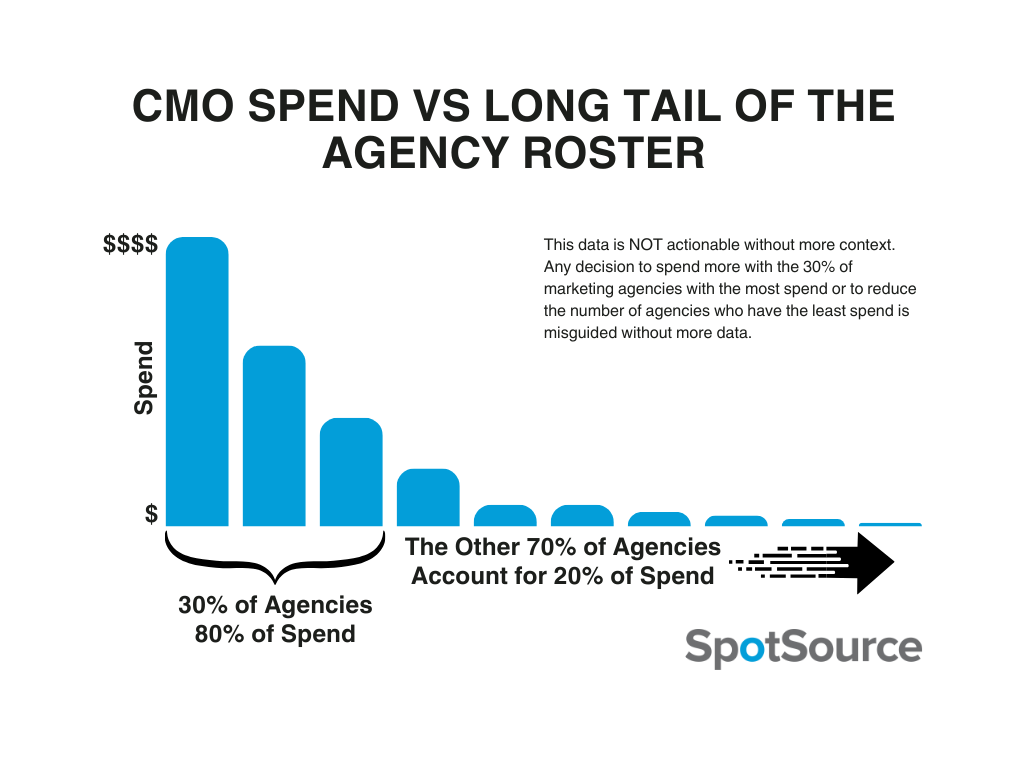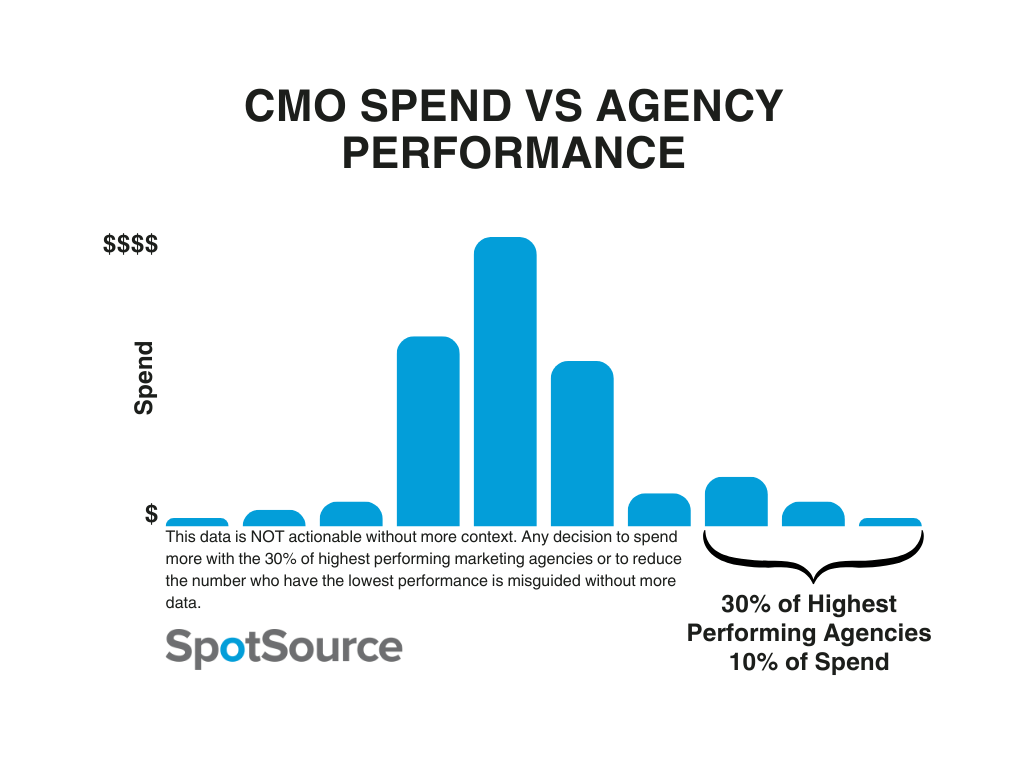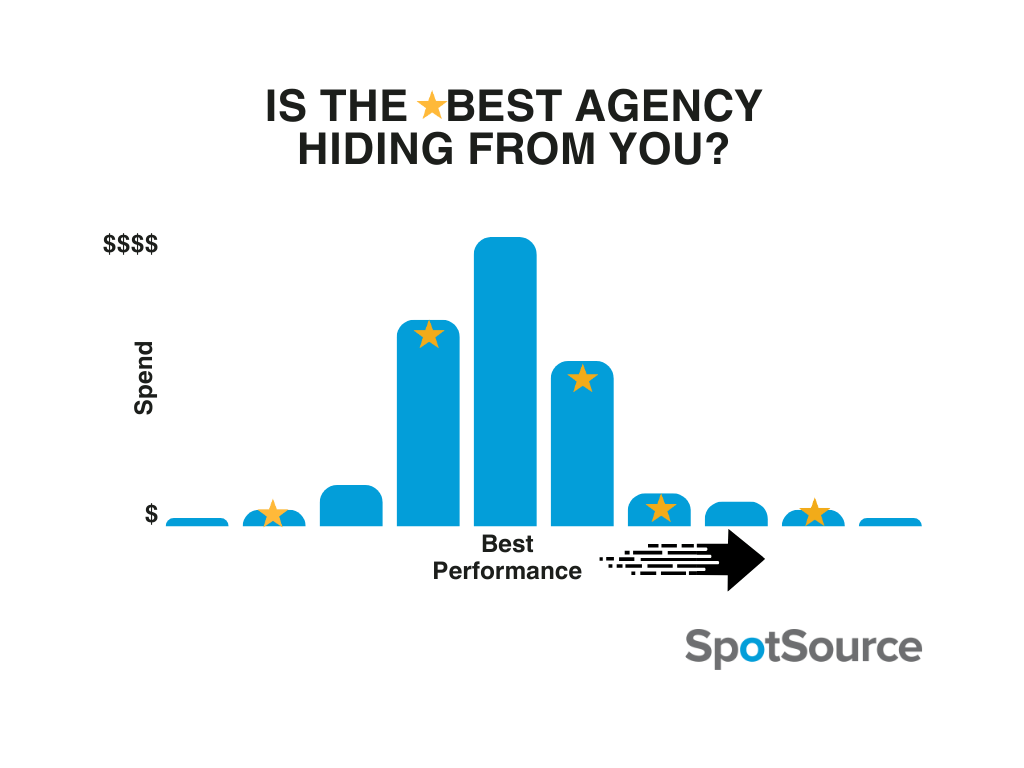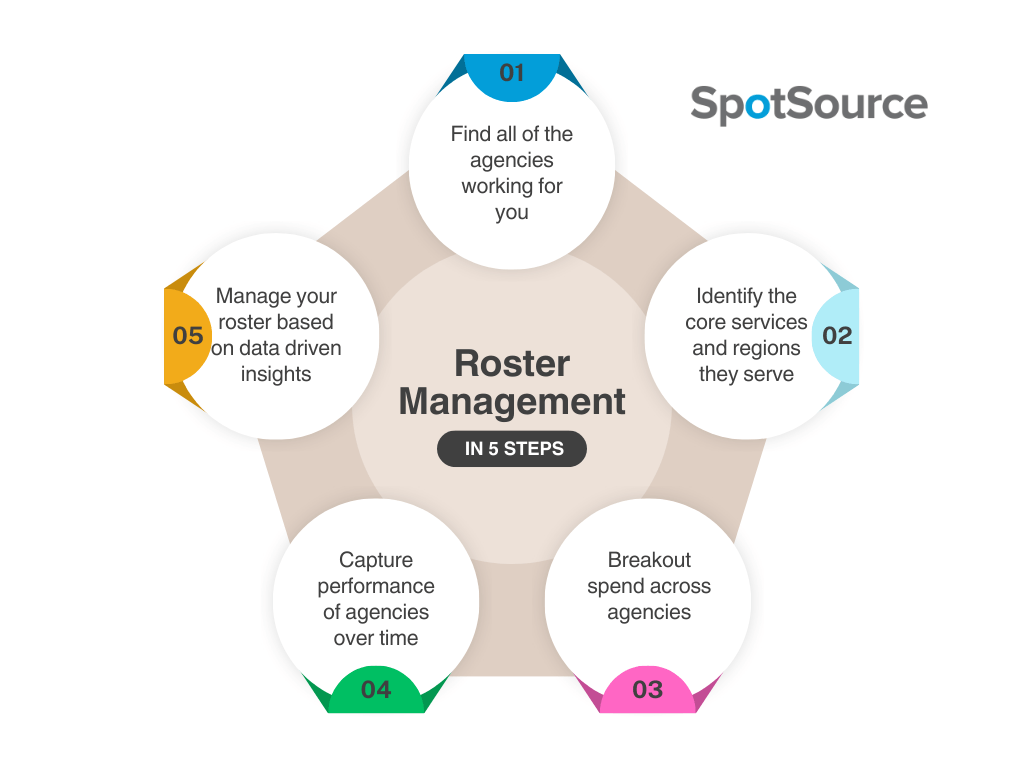The Data Driven CMO:
How to get the right data about your agency roster
This article is part of our Data Driven CXO series, helping C-Suite leaders explore data that can deliver competitive advantage.
Over the last twenty years, the marketing supplier landscape has become exponentially more complex. Marketing and sales has spent significant time and money on tools to reach the right customer and measure the success of marketing and advertising channels.
In many ways, marketing organizations have become extremely complex as a result. But, there are two big questions that remain largely untouched and which result in more marketing project failures and under performing projects than anything else.
Two big questions CMOs need to understand for continued success:
- Does the CMO have the right data to make strategic decisions about the agency roster?
- Do marketing teams have the right data to quickly find the best agency partner?
We are going to walk you through this problem and how to solve it for your company. While fixing it might get assigned out to Marketing Operations, Marketing Procurement, or Agency Management teams, it is critical that CMOs understand the truth behind the data.
Identify the right data, discover the truth
There are dramatically more digital channels than there were 20 years ago, which has led to the fragmentation and specialization across the marketing services industry. Whether you look at the number of marketing agencies, consultancies who now do marketing, or the proliferation of MarTech tools, the marketing supplier landscape is unrecognizable to those who were used to how it functioned before 2000. Similarly, the amount of data a company has across all these marketing suppliers is staggering.
Despite this proliferation of data, companies do not always have the right data and sometimes use the data they do have to draw flawed conclusions.
For example, I’ve often seen marketing procurement present the long tail of marketing suppliers, similar to the example below, in an effort to identify where they can reduce the number of agencies and MarTech suppliers. With just spend data, they try to recommend cutting off the long tail of agencies.
For the CMO and their marketing teams, this is a very dangerous decision to make without other supporting data. You could end up cutting some of your most high performing, well liked agency partners, or could cut a growing strategic agency who is helping bring some of your new products to market.

When CMOs look across their agency and MarTech roster of suppliers, they see all of the exponential growth and complexity mirrored across the many different tools and agencies represented. Since 2008, I have been working at and with companies struggling with this complexity. From Coca-Cola and other Fortune 500s to regional mid-market companies, I have consistently seen that CMOs and their teams do not have the right data to make key decisions about their agency roster.
No matter how much campaign data you have today, how do you know your teams have selected the right agency for each initiative? How do they know? What comparison data do they have access to? If you are achieving high performance, is the cost through the roof? Is there another team inside your organization whose agency is outperforming your agency partner based on spend?
Do you have the right data? Know what to ask?
If you chart the same roster of agencies and MarTech suppliers across performance data, you may get a very different distribution. Because professional services like marketing agencies are typically not a commodity, this “long tail” of your spend does not work the same as it might for other areas in the direct procurement space.

In direct procurement, you order a raw material or a widget that is highly specified. Any supplier in that space can deliver it, and it has to meet the specification. Most services, and certainly marketing agencies, cannot just be easily swapped out based on a specification. It is a human driven service where expertise in a craft and with different tools and channels makes a dramatic difference in outcome.
If you cut the 30% of marketing agencies you spend the least with, how do you know that some of them are not delivering oversized performance or aren’t critical to a growing part of your business?

CMOs need performance data across all agencies
Most organizations are only capturing agency performance data for the 5 – 10 agencies they spend the most with out of every 100-200 marketing agencies in their roster.
Typically, these 5 – 10 include your creative agencies of record, your media agencies or record, and a few others. Those relationships are dictated. The number of marketers who utilize them is well known. However, where there is choice, the rest of the organization is left with two choices:
- Make blind decisions (or nearly blind) on who is the best fit; or,
- Spend months trying to decide who to use because they don’t have the data already.
That is why, consistently collecting performance data, across the entire agency roster, is a key area of opportunity to drive the marketing excellence and outperform the competition.
It may sound easy, but the agency assessments that are being used for the top agencies are time intensive and will not scale easily. Five years ago, I spoke with a Fortune 500 global company in Germany who was trying to conduct these annual assessments across most of their 3,000 agency roster. They still have not achieved this feat. At the end of the day, it seemed nearly impossible or cost prohibitive, no matter how you orchestrate it, if you were using a traditional assessment approach.
But, systems out there, like my company, SpotSource, help your teams collect and use the performance data at scale so CMOs and their marketers can make sound decisions at every level of the organization. From agency roster strategy and bench strength to making it easy for the rest of the organization to make smarter data-driven decisions on the right fit agency for marketing projects, future marketing teams will demand that this supplier data be there and be easy to use. The question is, how quickly will you take advantage of this future to drive differentiation and advantage.
Performance data can come in a lot of flavors. We will talk about how to identify the specific performance data you need in a future article. Having a repeatable system to capture the data is half of the challenge.
The other half is presenting the data in a way that makes it extremely useful across the entire marketing department and the marketing procurement team as well.
Marketing teams of the future will demand agency performance data
Marketing teams struggle with the same problem as CMOs, a lack of the right data to make decisions. Inside the company, there is not a unified way to see across the approved roster of agencies and easily explore who is the best at a specific service, channel, or audience. In addition, many of these marketing teams can’t easily check if a supplier has an active contract, who they have been working with, or if they have been approved to handle certain areas of risk like Personal Identifiable Information (PII).

To over simplify things, a marketer trying to look across an agency roster faces many challenges. Imagine receiving a spreadsheet or a powerpoint with the agency roster in it. Guess how many of your top questions are answered in it? Hint: Its probably less than one.
A typical rundown of the first 5 questions a marketer needs to answer are all things that are not usually easy to find in a traditional procurement system in order to build a shortlist of agencies.
- Who does the service I need?
- Does the agency location matter?
- Do they have experience working in this space and for our company or my brand?
- How did they perform on similar work?
- Are they in my budget range?
These data roadblocks are exactly what the CMO needs removed in order to continue to transform marketing and drive competitive advantage through performance. All marketing organizations will have this data at their fingertips in the future. How quickly will your company take advantage of that future?
Unfortunately, the existing supplier management tools and ERPs where these suppliers reside inside most companies do not capture, track, and deliver all the different data that marketing decision makers need. In addition, many marketers experience additional delays because they have to go through marketing procurement in order to get access to the data that does exist in these traditional procurement systems.
Even something as simple as the key contact at a rostered agency is a frustrating barrier and time waste today. After reaching out to thousands of agencies, SpotSource has found that key contacts provided by procurement systems will be wrong or bounce more than 70% of the time. Imagine having spent the time researching agencies on the roster and when you finally reach out to the top three, two out of three emails bounce.
This inefficiency is not only costly but it is demotivating. It also leads to overspend and the rushed addition of new marketing agencies into your agency roster. If you can’t see who is doing a great job at what you need within the roster, most marketers will go around the system one way or another.
In doing so, huge amounts of time and energy are wasted. Not only the team members time, but opportunity cost adds up. Your marketing organization is operating slower than it needs to and is missing out on go-to-market opportunities.
With procurement seeing headcount cuts in recent years and enterprise systems requiring them to look up data across an average of three systems for each marketing supplier, procurement is seen as a roadblock by many instead of the strategic partner they could be.
Removing roadblocks to transform marketing
CMOs have the power to turn this around. By transforming how the marketing roster is managed and automating the collection of performance data, CMOs can both help their teams and improve the relationship between marketing and procurement.
Many teams have turned to a system like SpotSource in order to improve self-service while keeping marketing procurement in control of configuring guardrails for risk mitigation and compliance related to sourcing and working with marketing agencies. SpotSource handles these natively with it’s projects module, integrations with risk management systems, payments systems, data lakes, and its own proof of execution approval workflow.
At the end of the day, one of the biggest untouched areas to transform marketing has to do with better collecting, organizing, and sharing of data about all the marketing agencies and suppliers across your agency roster.
A user-friendly, data-driven approach has the ability to turn your team’s search for a new agency from months to minutes. With that productivity gain alone, saving your team months of time is worth investing in, especially when it means they will make decisions that reuse existing agencies, ensure project success, adhere to corporate risk and compliance, and will often lead to better marketing outcomes.
We recommend 5 key things a CMO or an agency management team can do to better serve their organization, bringing truth and transpartency to the agency roster. These five steps improve the organizations ability to manage the agency roster at a strategic level and removes barriers so team members can make the best choice possible on marketing projects and bids.

5 Steps to Better Agency Roster Management
- Find all of the agencies working for you (Optional: Include MarTech too)
- Identify the core services and regions they serve
- Breakout spend across agencies (What do you typically spend with each?)
- Capture performance data on agencies over time
- Manage your roster based on data driven insights
How you go about each step matters. Today, much of this data, if it exists, it fragmented and isolated. A team might have captured it for a few agencies at a point in time and only the people who were part of that team when it was created even know about the powerpoint or spreadsheet. It does nothing to help the overall strategy of the CMO or the rest of the marketing organization trying to hire the best agency for each project.
As you improve your agency roster and turn it into a differentiator, it is critical that the data you capture is in a system that is continually updated and is accessible across all of marketing. That transparency paired with data that is true will lead to better outcomes, improved speed to market, and cost savings. Systems like SpotSource make it easy to revolutionize your agency roster, collect performance data, and deliver value on many fronts all in a package that is easy to use for all of your marketing team members.
To learn more about SpotSource and how companies are launching internal Agency Marketplaces and more using SpotSource technology, please take a look at our marketing use case.
Sources:
- Chiefmartec Martech Landscape: This source illustrates the explosive growth of marketing technology tools over the past two decades, a critical factor driving the complexity of marketing services and the supplier landscape. The Martech Landscape Supergraphic captures the number of tools growing from a few hundred to over 8,000. Learn more here.
- Forrester Consulting, The Complexity Conundrum (2023): This report discusses how complexity in marketing operations, especially with agencies and external vendors, is rising due to the digital transformation of marketing. It highlights the growing challenge for CMOs to coordinate various specialized partners. Read more here.
- McKinsey, The Changing Face of Marketing: This report outlines how the introduction of data analytics and advanced martech platforms has changed the role of marketing agencies, often requiring them to specialize in specific areas, further adding to the complexity of managing multiple suppliers. Access the McKinsey report (McKinsey & Company).
- Quad’s Marketing Integration Report (2023): This study dives into the complexity brands face when managing multiple agency relationships and how agency fragmentation is impacting marketing efficiency and integration. Access the report here.

